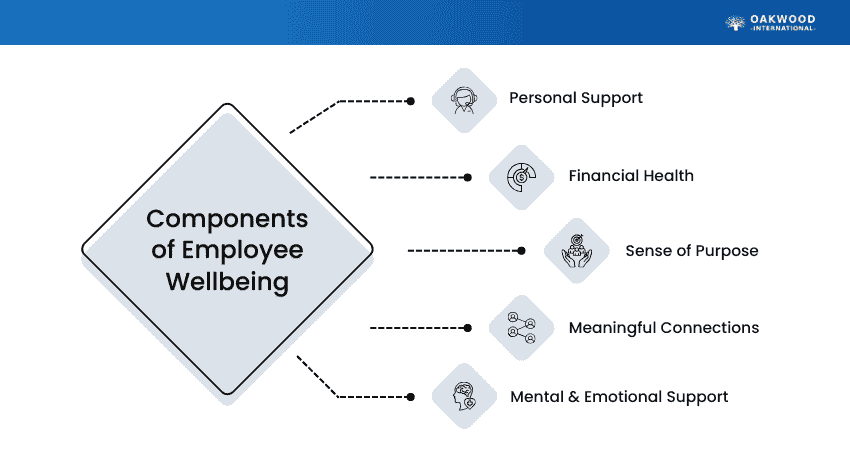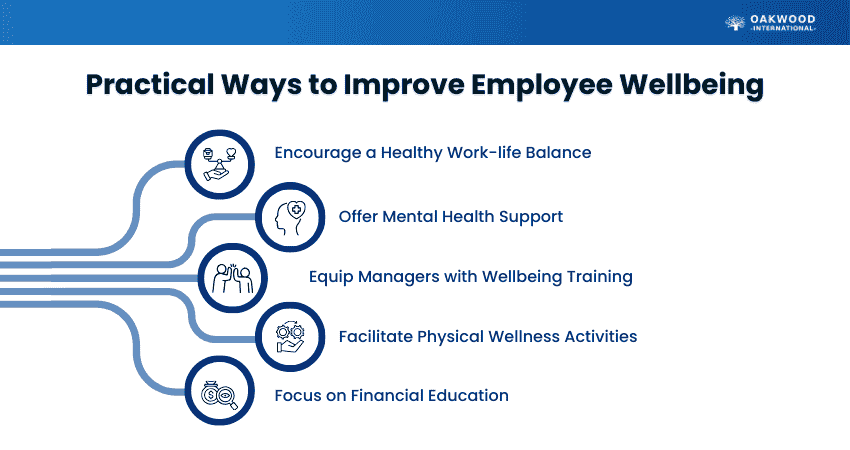Table of Contents


How employees feel at work is as important as the work they deliver. When stress levels rise and the line between work and life gets blurry, employees feel overwhelmed and disconnected. This is why Employee Wellbeing is a top priority for organisations striving to create a supportive and healthy workplace environment.
Whether you are a manager or an employee, your experience has an effect on the workplace culture. A positive workplace culture boosts your energy, motivation, and satisfaction. This enables building of a happier and engaged team. So, in this blog, you will learn about Employee Wellbeing, its benefits, essential components, and more in detail.
What is Employee Wellbeing?
Employee Wellbeing is a holistic approach that aims to support the overall health, happiness, and satisfaction of employees in the workplace. It goes beyond your physical health and includes emotional, mental, social, and financial aspects of a person’s life. A strong wellbeing strategy addresses how work affects an individual’s quality of life.
It includes factors like stress levels, work-life balance, job security and sense of purpose. It also lets you have access to resources like counselling or flexible schedules. Companies that value and invest in Employee Wellbeing often see improvements in morale, collaboration, and team performance.
Why is Employee Wellbeing Important?
Employee Wellbeing is crucial for building a productive, engaged, and resilient workforce. Here are the reasons why it matters:
1) Holistic Approach: Covers physical, mental, emotional, social, and financial health.
2) Mental Health Support: Offers counselling, stress management, and emotional wellbeing resources.
3) Work-life Balance: Encourages flexible hours and personal time.
4) Physical Wellness: Promotes fitness, ergonomics, and healthy habits.
5) Financial Security: Provides education, fair pay, and support for financial planning.
6) Social Connection: Builds team spirit and a sense of belonging.
7) Purposeful Work: Aligns roles with personal values for greater meaning.
8) Supportive Culture: Ensures open communication and strong leadership.
9) Positive Environment: Fosters respect, recognition, and psychological safety.
10) Continuous Efforts: Requires ongoing efforts, regular feedback, and adaptability.
Turn Mondays into motivation - Master Employment Law Training today!
Components of Employee Wellbeing
Employee Wellbeing is multi-dimensional as it surrounds various areas of life that influence how employees feel and function at work. Below are the key components that shape team wellbeing:

1) Personal Support
A workplace that is rooted in trust, respect, and security enhances Employee Wellbeing. Having supportive managers who encourage flexibility, provide autonomy, and help employees grow in a positive environment where individuals feel valued and perform confidently.
2) Financial Health
For strong Employee Wellbeing, financial stability plays a major role. When employees are paid fairly, they can manage expenses, and their stress levels decrease. Companies must prioritise fair compensation, equal pay, and financial wellness programmes to build a sense of security among employees.
3) Sense of Purpose
Employees want to be assured their contributions matter. When employees feel fulfilled, see meaningful progress, and understand how their roles contribute to goals, they become connected to the organisation’s purpose. This builds a sense of purpose in them and boosts their engagement towards business goals.
4) Meaningful Connections
Strong and healthy relationships at work foster a sense of belonging. When employee's leaders show genuine care and inclusivity, employees feel supported and valued. This encourages teamwork, healthy social connections, and an inclusive culture rooted in psychological safety.
5) Mental & Emotional Support
Employees thrive when they feel psychologically safe and secure. Positive mental support helps individuals to approach challenges with confidence, optimism, and resilience. When organisations provide mental health resources, employees are equipped with the necessary practices and techniques to handle pressure effectively.
What are the Benefits of Employee Wellbeing?
Employee Wellbeing creates a positive and healthy work environment where employees feel valued, supported, and motivated. When organisations prioritise wellbeing, both employees and the business benefit in meaningful ways. Below are some key benefits.

1) Improved Morale
Employee Wellbeing initiatives help employees to effectively manage stress and feel supported. When people are positive about coming to work, everyday tasks become enjoyable and fulfilling.
2) Increased Productivity
A healthy and energetic workforce can give its best performance. Supporting Employee Wellbeing through programmes, such as mental health resources or wellness activities, help to boost efficiency in employees.
3) Better Employer Brand
In a competitive job market, the top talents observe closely how businesses treat their employees. Companies that focus on Employee Wellbeing attract competent and talented people and enjoy a positive employer reputation.
4) Improved Retention Rates
Employee Wellbeing helps employees to feel respected, supported, and loyal to the company. This helps in reducing the turnover rates and retaining skilled and experienced workers for the long-term.
5) Less Absenteeism
A supporting and healthy Employee Wellbeing leads to less absenteeism and prevents burnout. When employees miss fewer workdays, productivity remains consistent, and teams spend less time catching up on delayed deadlines.
Enhance organisational efficiency and planning skills with Workforce Resource Planning Training – Register today!
How to Improve Employee Wellbeing?
Enhancing Employee Wellbeing needs to address physical, mental, emotional, social, and financial needs. Organisations must include wellbeing in their culture as a core business priority. Below are the key methods to enhance the same:

1) Encourage a Healthy Work-life Balance
To help employees maintain strong productivity levels, organisations should offer flexible working hours and realistic workloads. Recognising productivity, creativity, and healthy boundaries keeps employees more engaged, positive, and motivated.
2) Offer Mental Health Support
Mental wellbeing should be a top priority for organisations. Giving access to counselling services, stress-awareness programmes, and mental health training ensures employees are provided with the necessary help to feel safe and healthy.
3) Equip Managers with Wellbeing Training
Managers and leaders strongly influence the workplace culture. It is important to train them to recognise burnout, communicate with empathy, and support career growth. Such leaders provide the right tools to create a ripple effect of positivity across the organisation.
4) Facilitate Physical Wellness Activities
A healthy body supports a healthy mind. Organising initiatives such as walking meetings, standing desks, or wellness challenges encourages employees to stay active. These small adjustments promote movement, reduce stress, and improve daily energy levels.
5) Focus on Financial Education
Financial stress can negatively affect mental health and focus. Offering workshops on budgeting, saving, and investment provides resources to empower employees. This helps to keep employees secure and confident in their personal finances
Unlock peak performance with our Performance Appraisal Training – Join now!
Tips for Building Effective Employee Wellbeing Programmes
It requires strategic planning, active leadership, and adaptation to build a successful Employee Well-being. Below are key steps and tips to ensure your wellbeing initiatives are impactful and sustainable.
1) Planning a Wellbeing Agenda
Begin by understanding employee needs through surveys, feedback, and permitted health data. Setting clear goals, such as higher engagement or lower absenteeism, shapes inclusivity. Also, ensure leadership commits the right budget and resources for wider implementation.

2) Pinpoint Key Areas for Improvement
Here, review HR trends, such as turnover, sick leave, and survey scores, to identify gaps in wellbeing. Prioritise high-impact issues like mental health and work-life balance, and tailor the team's needs. This makes employees supported and valued. Also, conduct stay interviews to learn what employees require.
3) Lead by Example
Leaders must model healthy behaviour, such as setting boundaries, taking breaks, and seeking support. Through open communication, it builds trust and joining wellbeing activities shows commitment to Employee Wellbeing. This brings wellbeing as a part of the organisation’s identity.
4) Upskill Managers
It is important to equip managers to support Employee Wellbeing through training in recognising burnout, having supportive conversations, and referring staff to help. Practical toolkits and encouraging regular check-ins help to value wellbeing. This helps to foster healthy and productive teams.
5) Be Strategic About Recognition
Appreciation and recognition of employee efforts boost morale and encourage positive behaviours. By celebrating performance, teamwork, resilience, and wellbeing, everyone feels connected to their work. Also, make praise timely and specific by using different channels to value the workforce.
6) Evaluating the Major Barriers to Wellbeing
It is essential to identify what is holding employees back. It can be a workload issue, unclear roles, or limited resources. Using anonymous listening tools to uncover concerns while planning bigger cultural changes ensures Employee Wellbeing is supported. Based on this, policies can be reviewed, and changes can be implemented.
7) Integrate Wellbeing and Recognition Practices
Employee Wellbeing should be a core part of daily work. Adding wellbeing check-ins, walking meetings, and mindful moments is highly effective. Also, include wellbeing goals in performance reviews and demonstrate values of wellbeing through programmes and initiatives to build a supportive and lasting workforce.
Conclusion
A workplace grows stronger when its people feel valued, supported, and motivated. Employee Wellbeing is a strategic investment to improve productivity, loyalty, and sustain long-term success. When organisations genuinely care for their employees, they promote environments where everyone thrives and performs at their best. This shapes a workplace where people feel proud to belong.
Happy teams perform better – Discover Talent Management Training that works!


 Back
Back



 Back to Catagories
Back to Catagories





 + 44 7452 122728
+ 44 7452 122728










